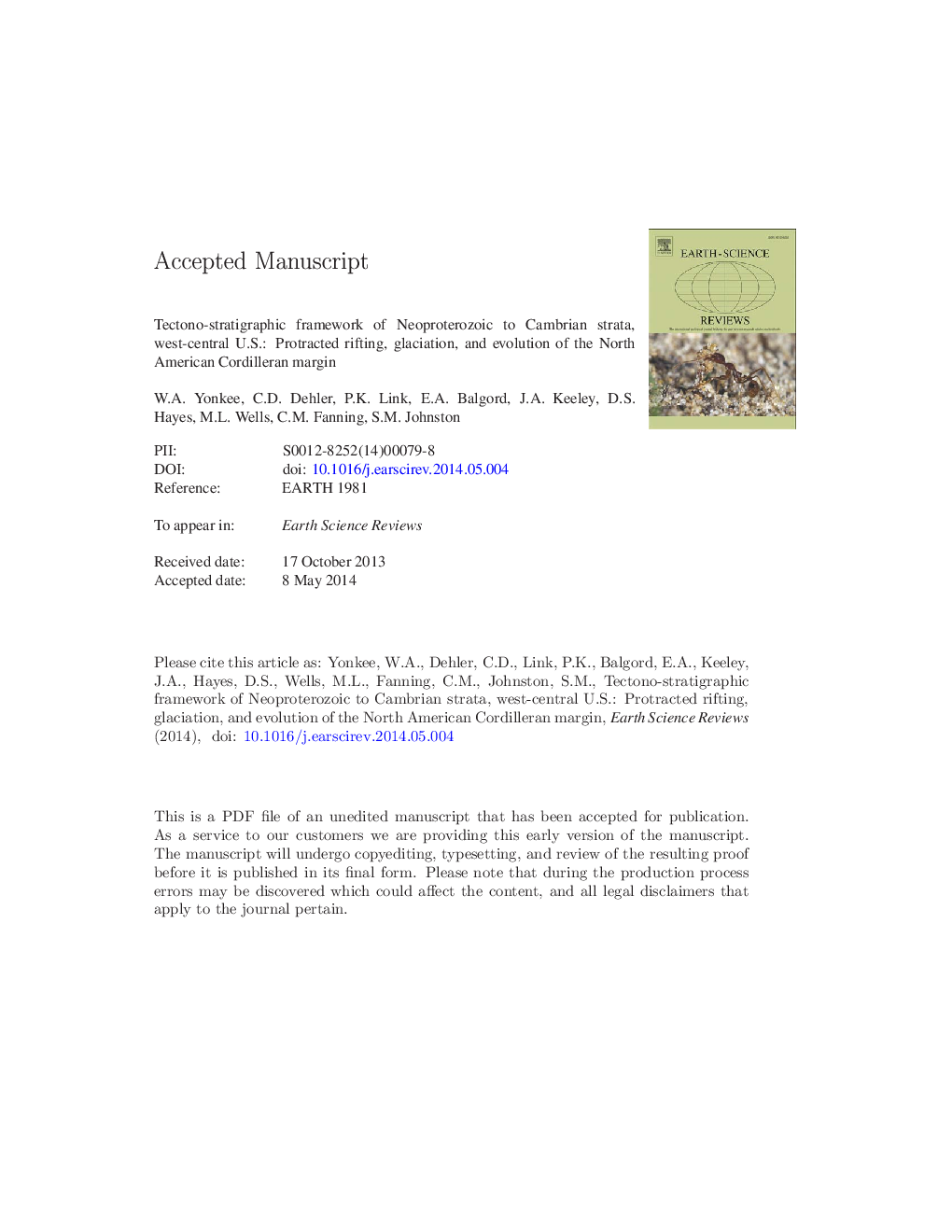| کد مقاله | کد نشریه | سال انتشار | مقاله انگلیسی | نسخه تمام متن |
|---|---|---|---|---|
| 6443015 | 1639966 | 2014 | 95 صفحه PDF | دانلود رایگان |
عنوان انگلیسی مقاله ISI
Tectono-stratigraphic framework of Neoproterozoic to Cambrian strata, west-central U.S.: Protracted rifting, glaciation, and evolution of the North American Cordilleran margin
دانلود مقاله + سفارش ترجمه
دانلود مقاله ISI انگلیسی
رایگان برای ایرانیان
کلمات کلیدی
موضوعات مرتبط
مهندسی و علوم پایه
علوم زمین و سیارات
زمین شناسی
پیش نمایش صفحه اول مقاله

چکیده انگلیسی
Stratigraphic, geochronologic, and geochemical patterns of Neoproterozoic to Cambrian sedimentary and volcanic rocks in Utah, Nevada, and SE Idaho record a dynamically evolving landscape along the North American Cordillera margin, which included: (1) initial development of intracratonic basins with deposition of siliciclastic strata of the Uinta Mountain Group from ~Â 770 to 740Â Ma; (2) early rifting and volcanism along a N-S (present day geographic coordinates) basin system with deposition of diamictite-bearing strata of the Perry Canyon and related formations from ~Â 720 to 660Â Ma; (3) early, broad subsidence with deposition of mature siliciclastic strata of the lower Brigham and McCoy Creek groups from ~Â 660 to 580Â Ma; (4) final rifting, volcanism, and transition to drift with deposition of variably immature siliciclastic strata of the Prospect Mountain and correlative formations from ~Â 570 to 520Â Ma; and (5) regional subsidence along a passive margin with deposition of Middle Cambrian to Devonian carbonate-rich strata. The Uinta Mountain Group comprises fluvial to marine, feldspathic to quartzose sandstone, conglomerate, and mudstone, with detrital zircon (DZ) patterns recording a mix of local basement sources to the N and distal Laurentian sources to the SE. The lower Perry Canyon and related formations contain variably feldspathic sandstone, quartz-pebble diamictite deposited during an older glacial episode, and mudstone, with DZ patterns recording a mix of distal sources, local basement sources, and sediment recycling during early rifting. The upper Perry Canyon and related formations contain mafic volcanic rocks, polymict diamictite deposited during a younger glacial episode, volcaniclastic wacke, and mudstone, with DZ patterns recording local basement sources along an evolving rift margin and felsic volcanism from ~Â 700 to 670Â Ma. Mafic volcanic rocks and trachyte to rhyolite clasts in diamictite have geochemical signatures typical of continental rifting. The lower Brigham and McCoy Creek groups contain mostly mature quartz arenite deposited in shallow marine environments, with DZ patterns recording distal Laurentian sources. The base of the Prospect Mountain and correlative formations is marked by an influx of feldspathic, coarse-grained sediment derived from local basement sources and ~Â 570-540Â Ma basalt volcanism, which was followed by deposition of subfeldspathic strata with dominant 1.7-1.8Â Ga DZ grains, recording sources from the SE rift margin and a marked decrease in distal sources during uplift of the Transcontinental Arch. Overlying carbonate-rich strata were deposited in shallow marine settings, with episodic influx of siliciclastic sediment derived from basement exposed during regressions. Stratigraphic thickness-age relations of Neoproterozoic to early Paleozoic strata are consistent with two episodes of rifting concentrated at ca. 700-670Â Ma and 570-540Â Ma along western Laurentia, leading to final development of a passive margin. Early rifting was incomplete with an estimated 25-40% extension of initially thick lithosphere that was weakened by igneous activity. Final rifting of previously thinned lithosphere involved an estimated 20-35% additional extension, renewed igneous activity, and thermal thinning of mantle lithosphere, with localized extension culminating in final separation along the continental margin. Stratigraphic, geochronologic, and available paleomagnetic data are consistent with linkage of western Laurentia to Australia-East Antarctica within Rodinia, followed by protracted rifting and drift during Cambrian time.
ناشر
Database: Elsevier - ScienceDirect (ساینس دایرکت)
Journal: Earth-Science Reviews - Volume 136, September 2014, Pages 59-95
Journal: Earth-Science Reviews - Volume 136, September 2014, Pages 59-95
نویسندگان
W.A. Yonkee, C.D. Dehler, P.K. Link, E.A. Balgord, J.A. Keeley, D.S. Hayes, M.L. Wells, C.M. Fanning, S.M. Johnston,